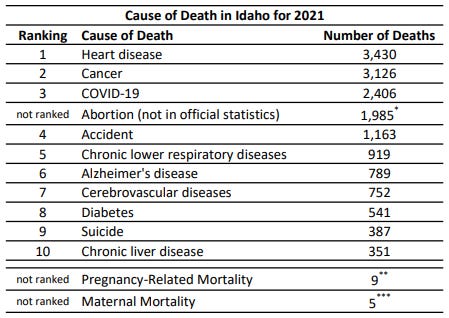Unraveling Maternal Death Rates & The Capital Sun's Misleading Statistics
Editorial by IDFC Member Rep. Tony Wisniewski
Misleading Maternal Death Rate Statistics
On June 30, 2023, the Capital Sun published an article discussing the surge in US maternal mortality rates and the decision by Idaho to discontinue its panel investigating pregnancy-related deaths. However, it is important to note that the statistics mentioned in the Capital Sun article, particularly regarding maternal death rates in Idaho compared to the entire US, can be misleading and may create alarm.
Understanding Maternal Death Rate Classifications:
PRMR and MMR
To properly evaluate the significance of these figures, it is essential to understand the definitions of maternal death rates. There are two classifications of maternal death rates: the Pregnancy-Related Mortality Ratio (PRMR) and the Maternal Mortality Ratio (MMR).
Differences in Timeframes and Criteria:
PRMR vs. MMR
The PRMR includes “the death of a woman while pregnant or within one year of the end of a pregnancy—regardless of the outcome, duration, or site of the pregnancy—from any cause related to or aggravated by the pregnancy or its management.”
The MMR includes “the death of a woman while pregnant or within 42 days of delivery or termination, irrespective of the duration and site of the pregnancy, from any cause related to or aggravated by the pregnancy or its management, but not from accidental or incidental causes.”
The two classifications differ in the timeframes they look at and the rules they use to decide which deaths to include when calculating maternal death rates. The PRMR looks at deaths within one year after a pregnancy ends, regardless of what happened during the pregnancy or where it occurred. On the other hand, the MMR focuses on deaths within 42 days after giving birth or ending a pregnancy, no matter how long the pregnancy lasted or where it happened. Both include deaths caused by pregnancy-related factors.
Capital Sun’s Misleading Statistics
In the Capital Sun article, the reported rate of 41.8 for Idaho is the PRMR, while the rate of 23.8 for the US is the MMR.
Since these classifications have different time periods and criteria for counting deaths, it is not appropriate to compare them directly. To make a sensible comparison between Idaho and the US, we must use values from the same definition. Fortunately, the 2021 Idaho report by the same commission does this comparison.
Correcting the Record
Contrary to the Capital Sun report, Idaho has a significantly lower Maternal Mortality Rate than the US. Unfortunately, the Capital Sun did not follow standard journalistic practices of cross-checking the data, which has caused unnecessary public concern. Additionally, the article focuses on death rates rather than the actual number of deaths, further contributing to the misleading nature of the information.
Cross-Checking Data and Focusing on Actual Deaths
There are several reasons why extending the Maternal Mortality Review Committee may not be necessary. Firstly, the same maternal data can be obtained from epidemiology reports published by the Department of Health and Welfare, according to Marco Erickson, Vice Chair of the House Health and Welfare Committee.
Secondly, other regional states collect similar data, so duplicating efforts is unnecessary. Thirdly, detailed data already exists from Idaho available for the past four years. Continuous data collection may not be needed until meaningful action is taken to address the known causes of maternal deaths.
Putting Maternal Deaths in Perspective
Lastly, we have to put the maternal deaths in perspective with other causes of death. The top ten causes of death in Idaho for 2021 are listed in the table below.
Pregnancy-Related deaths are less than 3% of the tenth highest cause of death (liver disease).
*Find abortion statistics here
**22,427 live births in 2021, and a PRMR of 40.1 yields nine deaths
***22,427 live births in 2021 and a MMR of 22.3 yields five deaths
Pregnancy-Related Deaths in Relation to Total Deaths in Idaho
While even one preventable death is tragic, especially if the death leaves a motherless family behind, the number of pregnancy-related deaths is minuscule compared to the 18,334 total deaths in Idaho in 2021.
If tax-sponsored studies aim to save lives, it would be more beneficial to prioritize studying other causes of death that can potentially save many more lives.
When evaluating maternal death rates, it’s essential to rely on accurate data and not be influenced by misleading information. This approach allows us to make informed decisions and effectively address the real issues in maternal healthcare, ensuring the well-being of mothers and families.





